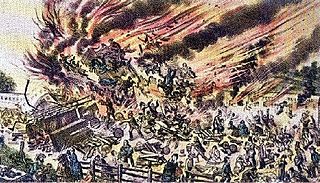
Bryn Athyn is a home rule municipality in Montgomery County, Pennsylvania. It was formerly a borough, and its official name remains "Borough of Bryn Athyn". The population was 1,375 at the 2010 census. It was formed for religious reasons from Moreland Township on February 8, 1916. Bryn Athyn is surrounded by Lower Moreland Township.
The Dugald rail accident was a head-on collision between two Canadian National passenger trains on September 1, 1947, in Dugald, Manitoba, Canada, resulting in the deaths of 31 people.

The Great Train Wreck of 1856 occurred in Whitemarsh Township, Pennsylvania, between Camp Hill station and Fort Washington station, on July 17, 1856. Two trains, traveling on the same track in converging directions, collided, killing between 59 and 67, and injuring over 100. The incident was referred to as The Camp Hill Disaster in Montgomery County, and The Picnic Train Tragedy in Philadelphia. It was the deadliest railroad catastrophe in the world up to that time and became one of the signature events of its era.

Bryn Athyn station is a former railroad station in Bryn Athyn, Pennsylvania. Built by the Reading Railroad, it later served SEPTA's Fox Chase/Newtown Line. It is located on Fetters Mill Road near the Pennypack Creek. The station is a contributing property to the Fetter's Mill Village Historic District.
Charles Henry Ewing was an American engineer and businessman who was president of the Reading Company from 1932–1935.

The Fox Chase Line is a SEPTA Regional Rail service connecting Center City Philadelphia with Fox Chase. It uses the Fox Chase Branch, which branches off from the SEPTA Main Line at Newtown Junction north of the Wayne Junction station. It runs entirely within the city of Philadelphia. The line is fully grade-separated, except for one grade crossing on Oxford Avenue.

The Esmond Train Wreck on January 28, 1903, 3:30 am, about 9 miles (14 km) east of present-day Tucson, Arizona, killed 14 people, including the engineers of both trains. The accident occurred when the eastbound Crescent City Express collided head-on with the westbound Pacific Coast Express. Both trains were running late. A communication error was determined to be the cause of the wreck. A night operator named Clough admitted that he did not deliver a second order to Conductor Parker which instructed him to pull the Crescent City Express, headed for New Orleans, on to the Esmond siding to allow the Pacific Coast Express, headed for San Francisco, to pass by.

The Pennypack Trail is a rail trail located in eastern Montgomery County, Pennsylvania in the United States. The trail runs 6.2 miles (10.0 km) from Rockledge north to the County Line Road border with Bucks County in Huntingdon Valley along the former alignment of SEPTA's Fox Chase-Newtown Line. The trail is maintained by the Montgomery County Division of Parks, Trails, & Historic Sites.






